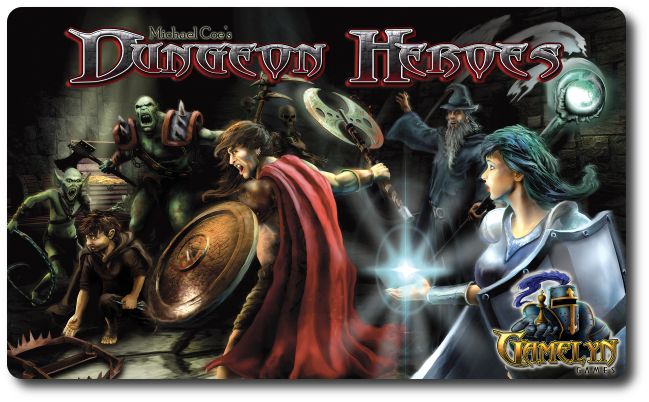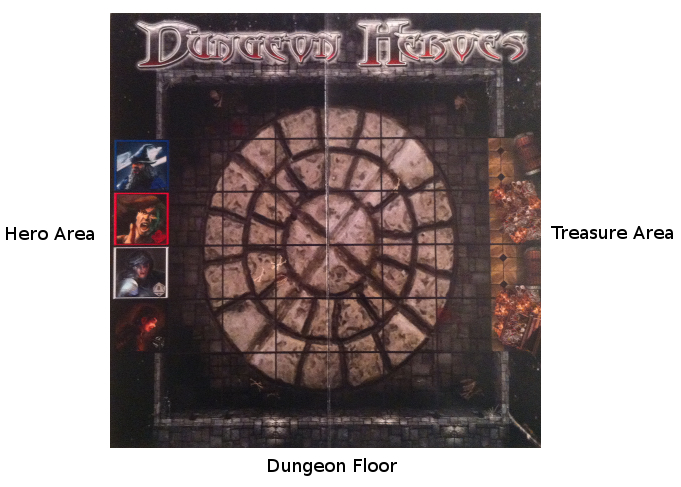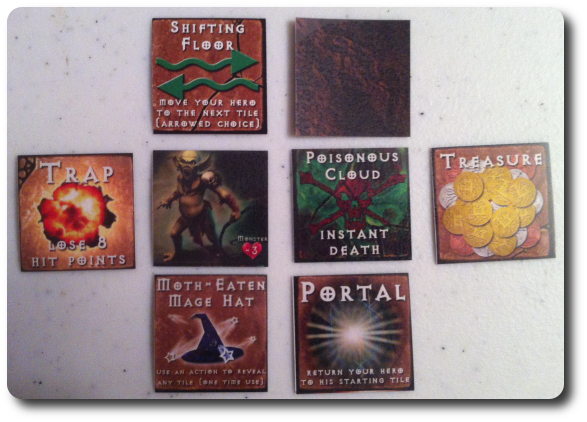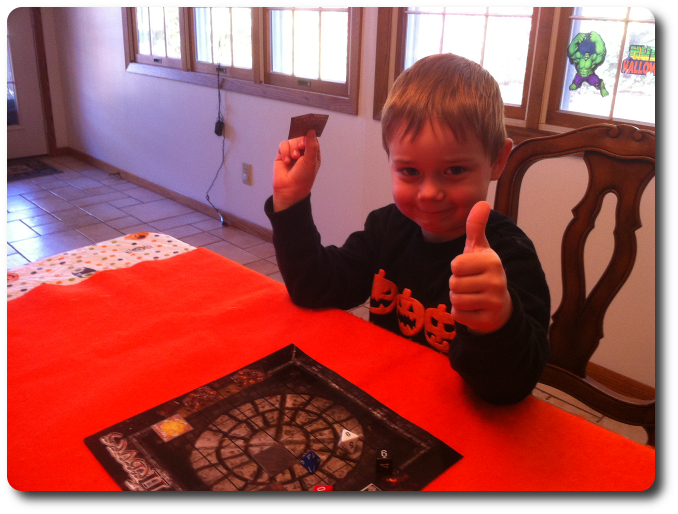Please Take Note: This is a review of the game’s final prototype. The art, game bits, and the rules discussed are all subject to change. The game is being reviewed on the components and the rules provided with the understanding that “what you see is not what you might get” when the game is published. If you like what you read and want to learn more, we encourage you to visit the game’s official web page or visit the game’s Kickstarter campaign. Now that we have all that disclaimer junk out of the way, on with the review!

The Basics:
- For ages 5 and up (publisher suggests 13+)
- For 2 players
- Approximately 20 minutes to complete
Geek Skills:
- Counting & Math
- Memorization
- Logical & Critical Decision Making
- Strategy & Tactics
- Risk vs. Reward
Learning Curve:
- Child – Easy
- Adult – Easy
Theme & Narrative:
- Venture down into a dungeon and grab the treasure or be eaten by monsters over your lunch break
Endorsements:
- Gamer Geek approved!
- Parent Geek approved!
- Child Geek approved!
Overview
Stop me if you have heard this one. A Warrior, a Wizard, a Rogue, and a Cleric walk into a dungeon to get some loot. They find some monsters, beat them up, steal their treasure, and do their best to survive. Now here’s the punchline. An epic adventure of dungeon exploration can be had in less time than it takes you to eat your lunch, pay your bill, and regret eating that 12″ sub with extra bacon. All the components for a quick dungeon crawl, complete with exploration and danger, are here and ready for two players who want to do something constructive while they digest their meal.
Dungeon Heroes, by Gamelyn Games, is comprised of 37 Dungeon tiles, 1 four-sided die (representing the Wizard), 1 six-sided die (representing the Rogue), 1 eight-sided die (representing the Cleric), 1 ten-sided die (representing the Warrior), 10 Monster tokens, and 1 game board. As this is a review of a prepublished game, we will note comment on the game’s component quality.
Game Set Up
To set up the game, first place the game board in the middle of both players and have one player sit behind the Hero Area (who is now the Hero player) and the other player should sit behind the Treasure Area (who is now the Dungeon Lord…bwahahaha).

Second, the Hero player will take the four dice and place them on the corresponding hero spaces located in the Hero Area. Each die will keep track of each hero’s location in the dungeon and hit points (health). All heroes start with full health, meaning the highest number value is on top and showing on each die.
Third, the Dungeon Lord (bwahahaha) should look through the Dungeon tiles and take 1 treasure Dungeon tile. This tile is placed in one of the Treasure Area spaces on the game board, face-up. The remaining Dungeon tiles are placed in a cup or a bag or whatever. The point is to get them all in one place so it is easy to draw a tile randomly.
Fourth, the Dungeon Lord (bwahahaha) places the 10 Monster tokens to one side of the game board.
That’s it! You are now ready to play!
Lasciate Ogne Speranza, Voi Ch’intrate!!!!
The game is played in rounds. During each round, each player has four action points to spend. The Dungeon Lord (bwahahaha) gets to go first.
The dungeon begins in a passive state. The monsters won’t go out of their way to attack and the heroes have an opportunity to explore the dark depths in relative safety. I say “relative” because there is still inherent danger, but the heroes will have to look for it versus danger looking for them. And by danger I mean monsters and traps. Here’s a quick breakdown of what a hero can expect to find in a dungeon:
- Monsters: these will reduce the health of a hero and can only be killed by the Warrior
- Traps: these will reduce the health of a hero and can only be disarmed by the Rogue
- Poisonous Clouds: any hero who passes through them will instantly die, but by doing so, the tile is removed (note that monsters are smart enough to NOT move through this tile)
- Shifting Floors: forces a hero to move one space in a specific direction and is then removed from the game
- Portals: magically moves a hero back to their starting position in the Hero Area and is then removed from the game
- Special Items: a surprisingly useful tool haphazardly discarded on the dungeon floor that can be equipped by the hero who finds it and used once during the game

Example of some of the many Dungeon tiles included in the game
On the Dungeon Lord’s turn (bwahahaha), 4 Dungeons tiles are randomly selected, looked at, and then placed face-down on the dungeon floor. Each Dungeon tile placement counts as one action and cannot be placed in the Hero Area, the Treasure Area, or on any spot where a hero is currently located. Once the Dungeon Lord (bwahahaha) is finished placing their tiles, the Hero player has a turn.
The Hero player has a number of choices for their actions. A single action can include the use of a hero’s special ability, movement, or use of a special item the hero might have picked up. Each Hero may only take a maximum of 2 actions per turn.
When moving in the dungeon, a hero may never, ever move onto a space occupied by another hero or pass through it. This is a fast dungeon crawl and the dungeon itself is rather cramped. If a hero is ever moved onto a space with an unrevealed tile, the hero instantly stops moving and the Dungeon tile is revealed.
The actions for each hero are briefly explained here:
The Great and Somewhat Powerful Wizard
The Wizard can move 1 space per action diagonally or orthogonally. Additionally, using dark and dangerous arcane powers, any 1 Dungeon tile can be revealed for a cost of 1 action.
The Slightly Enraged Warrior
The Warrior can move 1 space per action orthogonally. Additionally, because of his ridiculously sharp sword and penchant for swinging it wildly, any monster Dungeon tile the Warrior lands on by moving onto its space is killed and removed from the game. It is important to note that if any other hero is foolish enough to land on a monster or unluckily reveals one, they will take damage equal to the number indicated on the monster Dungeon tile, reducing their Hero’s health accordingly, but the monster remains.
The Overly Pious Cleric
The Cleric can move 1 space per action orthogonally. Additionally, the Cleric can summon the awesomeness of their deity to heal 2 points of health on any one adjacent Hero (including the Cleric) for 1 action.
The Shifty and Stupidly Handsome Rogue
The Rogue can move 1 space per action diagonally or orthogonally. Additionally, the Rogue is able to disarm traps by landing on the trap Dungeon tile. Disarmed traps by the Rogue or traps sprung by other heroes are removed from the dungeon floor and for the duration of the game.
After the Dungeon Lord (bwahahaha) and Hero player have finished their turns, a new round begins. This continues until the Dungeon Lord (bwahahaha) has placed all the Dungeon tiles. Then things get interesting…
Ready, Fight!
Up until now, the dungeon as been passive. Nothing is going out of its way to attack or harm the heroes. Even revealed monsters will not attack a hero until the hero lands on them. Once the last Dungeon tile has been placed, the dungeon comes to life and is now considered all kinds of aggressive. This also means the Dungeon Lord (bwahahaha) can start moving the monsters to attack the heroes!
The first thing done when the dungeon turns aggressive is to replaced all revealed monster Dungeon tiles with a numbered Monster token. Each monster Dungeon tile has a number. Replace the tile with a token of the same number. The number on the token indicates how much damage is inflicted on a hero when the monster attacks. A monster attacks a hero automatically whenever a hero is in an adjacent space on the Dungeon Lord’s (bwahahaha) turn.
The available actions for the Dungeon Lord (bwahahaha) change in an aggressive dungeon, but the actions for the Hero player remain the same. The Dungeon Lord (bwahahaha) can now do the following on their turn for 1 action each:
- Reveal 1 Dungeon tile. If the Dungeon tile is a monster, replace the tile with a Monster token immediately. A Dungeon tile currently occupied by a Monster token cannot be revealed by the Dungeon Lord (bwahahaha) or the Wizard’s special ability.
- Move 1 Monster token 1 space for 1 action. Monsters can move orthogonally. Monsters cannot move onto or through any space that contains a hero or a monster. Monsters can move onto unrevealed tiles, but do not trigger tile effects.
- Attack a hero in an adjacent space for 1 action. A monster automatically attacks a hero for free if it ends its movement adjacent to a hero, but only one hero can be targeted. Note that any monster that is foolish enough to attack the Warrior will inflict damage but will then be killed.
In the very likely event that at least one hero will perish in the dungeon, the die that represents the hero is removed from the game. If the hero had a special item, it “drops” and is placed on the same space where the hero perished. Tiles can “stack”, which means it is perfectly possible to have a special item drop on a monster or another special item.
Victory and Defeat
If all the Dungeon tiles are revealed and the Dungeon Lord (bwahahaha) has no more Monster tokens to move, the game is over and the winner is determined. If the Hero player has a safe path to reach the remaining treasure Dungeon tiles needed to win (4 in total) with at least one hero surviving, the Hero player is the winner. Otherwise, the Dungeon Lord (bwahahaha) is victorious!
To learn more about Dungeon Heroes and read the complete rules, visit the game’s official web page or visit the Kickstarter page.
Prediction
A simple and fast dungeon crawl is exactly what I need nowadays. First of all, and as suggested by the game publisher, a quick game at the office over the lunch hour would be an excellent change of pace and a wonderful distraction from the rigors of office politics Second, my little geeks love to play dungeon crawlers, but these games take a while to set up and to play. Having access to a quick dungeon crawl game would satisfy their gaming itch and reduce the amount of time it takes to get the game off and on the table.
Dungeon Heroes is not a complicated game when it comes to the rules. There are choices to be made and tactical moves to be had, but the strategy is always the same. Survive. For the Hero player, this means staying nimble and out of harms way as much as possible, utilizing the heroes and their special abilities to outlast the Dungeon Lord (yes, we are done with the whole evil laugh thing). The Dungeon Lord needs to focus on putting monsters and traps in front of the Hero player, but is also forced to put down tiles that could benefit their opponent. In essence the Dungeon Lord gets to control the mine field in the passive phase and then move the mines in the aggressive phase. It is somewhat beneficial to keep the biggest monsters to the rear with the treasure and populate nothing but traps and smaller monsters to harass the heroes up front until such time the dungeon “wakes up” and starts to kick butt.
Teaching the game doesn’t take long, and depending on the level of ability of your opponent, you can assign them to be the Hero player or the Dungeon Lord. Both roles play differently with some similarities but I would argue that the Dungeon Lord takes less thinking. This makes it the perfect player role for those players who suffer vapor lock when presented with too many choices or for new players learning the game. For my little geeks, I assigned them as the Dungeon Lord, which they absolutely loved. I decided to split the game instruction into two phases to match the two phases of the game. I gave them just enough instruction to play the passive phase well and reserved the new actions for the aggressive phase. But before I started our first game, I asked them their thoughts Dungeon Heroes.
“Awesome, awesome, awesome! I can’t wait to eat your heroes!” ~ Liam (age 8)
“Oh, yeah! I’m going to win and keep all the treasure, Daddy!” ~ Nyhus (age 5)
Like so many fallen Dungeon Lords before them, their level of exuberance is based on their overly developed sense of superiority. Let’s see if my heroes can knock through their defenses or if the little geeks have what it takes to run a dungeon like a Boss.
Final Word
As expected, the little geeks did very well with the first phase of the passive dungeon, thinking through their Dungeon tile placement, and keeping me guessing on what they were putting in front of me. Sometimes, and as predicted, they would place a monster or a trap. Other times, a useful item. I would suggest to my little geeks that they keep the “good stuff” away from the heroes, which they just smiled at and said “OK”. When the dungeon turned aggressive, I was most pleased to see that my little geeks had indeed kept their best monsters to the rear. But more importantly, they surrounded treasure with traps! Brilliant! This showed that they not only knew what the game was all about, but were demonstrating memory and tactics, fully realizing what their strategy had to be to win the game.
Parent Geeks had a great time with the game, both with their peer group and with their family. As far as the peer groups went, the only time the game didn’t take was when a Parent Geek battled against a non-gamer. The non-gamer had no idea what they were doing and became frustrated. Unless both players are enjoying the game and trying their hardest to win, the game falls flat. Not a knock against the game, but an important point to note when you choose your opponent. One Parent Geek suggested that Dungeon Heroes was like playing “blind” Chess. Now there’s a game I know I wouldn’t want to play.
The Gamer Geeks were somewhat less enthusiastic about the game, finding it to be casual and fun, but not as meaty as they would like. They agreed to approve it, however, based on the surprising depth of tactics one could use and the level of thinking needed to win against your opponent. They also gave it high marks for providing an enjoyable quick dungeon crawler experience that always felt different thanks to the random tile placement.

My little dungeon explorer gives me the thumbs up as we reset the game for the third time in a row
Gamer Geeks, this is a fast and casual dungeon crawler that is perfect for 2-player game nights, game fillers, lunch breaks, socializing at the pub, or when you are waiting in a long line to see the midnight showing of a movie. The game is small, plays big, and will keep you engaged from start to finish. This is due in part to the game’s “intelligent randomness”, which is a phrase I just coined and will soon seek legal ownership of. By intelligent randomness, I mean the dungeon is always going to be populated differently because of the random Dungeon tile pulls, but since there is a person who decides where those tiles are placed, there is a level of intelligence inherently built into the dungeon’s final layout. Note the level of intelligence is directly dependent on your opponent, but because the game is always different, both the Hero player and the Dungeon Lord will never know what to expect and will enjoy the act of discovery. In the end, your peer group rather liked this micro dungeon plunger.
Parent Geeks, this is a fun and fast dungeon crawler you can play with just about anyone in your family. Basic math and reading is necessary for the Hero player, but the Dungeon Lord need only recognize numbers and know the difference between a trap, a monster, and a special item. This is easily done by simply reviewing the tiles before the game. This also means the game is very easy to teach and should be accessible to your most non-non-non-gamer friends, although they might not appreciate (or even understand) the game’s theme. Best of all, the game is fast, sets up, and breaks down quickly. You won’t have any problem finding the space or the time to play this little dungeon explorer.
Child Geeks, finally a game that you can harass your parents to play and they won’t have any excuse to say no to! In Dungeon Heroes, you can take on the role of the heroic good guys or the most evil of dungeon bosses. Both sides of the board play differently, but if you learn how to play one role, you’ll understand how to play the other by default. The learning curve is easy on this one, but you’ll soon find that the “difficulty” in the game comes from trying to outsmart your opponent and attempting to guess what they are doing. Win or lose, you’re going to have a good time.
The closest game I can think of that is anything like Dungeon Heroes is Stratego, but much more fun and tolerable. This not necessarily a good comparison because one player knows where everything is at all times, if they can remember where they placed their tiles. Still, there are element of Stratego in the game that work well. For example, the placement of the big monsters and traps, and the need to position the treasure (or in terms of Stratego, the flags) as far away as possible from the Hero players. Ah, but there is so much more to it than that. Perhaps the Dungeon Lord places the objective right in front of the players, but surrounds them with dangerous monsters and traps? The Hero player simply won’t know until it is too late or through good game play. Either way, awesome.
Not included in the rules, but shouldn’t be a problem to add, are details for a solo game. I don’t see why a player couldn’t play as the heroes, simply randomly fill in the dungeon floor with tiles, and then add some additional rules for how the dungeon and monsters react during the aggressive phase. If it isn’t included in the game when it is released, I’m sure we’ll see a fan created rule-set, which is just as good. Until then, I’m more than happy with my print-n-play version of the game and it continues to get much playtime at the table. If I’m not playing it with my little geeks, they are playing it with their friends and among themselves. If ever there was a good indicator to determine if a game is a fun one or not, I suppose that’s as good as it gets.
If you are a fan of dungeon crawler games and fantasy, but don’t have the time to spend outfitting a band of heroes and exploring the depths of dank tombs for treasure, then do make the time to play Dungeon Heroes as soon as possible. It is sure to satisfy your craving for adventure within the limited time you have available.
This game was given to Father Geek as a review copy. Father Geek was not paid, bribed, wined, dined, or threatened in vain hopes of influencing this review. Such is the statuesque and legendary integrity of Father Geek.




Great review! Appreciate the efforts you make.
It is our pleasure!
Thanks for reading!